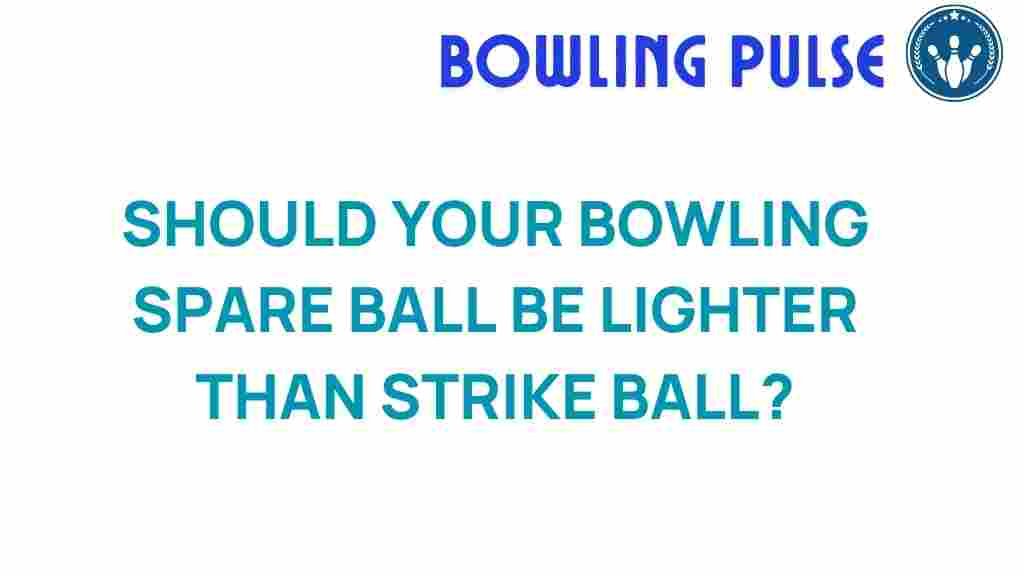The Great Debate: Should Your Bowling Spare Ball Be Lighter Than Your Strike Ball?
Bowling is a sport that combines skill, precision, and strategy. Among the many decisions amateur bowlers face, one of the most debated is whether to use a lighter bowling spare ball compared to their strike ball. This question touches on various aspects of bowling technique, performance, and equipment choice. In this article, we will explore the arguments for and against using different weights for your spare and strike balls, and provide insights to help you make the best decision for your game.
Understanding Bowling Balls: Spare vs. Strike
Before diving into the weight difference, it’s essential to understand the distinct roles of a spare ball and a strike ball:
- Strike Ball: This is typically a heavier ball designed for maximum pin action. A strike ball aims to knock down all ten pins in one throw.
- Spare Ball: This ball is often used to pick up remaining pins after the first throw. Many bowlers prefer a lighter spare ball to enhance control and accuracy.
The Weight Difference: Pros and Cons
The weight difference between your spare ball and strike ball can significantly impact your bowling performance. Let’s delve into the pros and cons of using a lighter spare ball.
Pros of a Lighter Spare Ball
- Improved Control: A lighter spare ball can make it easier to control your shots, especially when aiming for specific pins.
- Increased Accuracy: Many amateur bowlers find that a lighter ball allows for a smoother release, leading to better accuracy when converting spares.
- Less Fatigue: Using a lighter ball can reduce the strain on your arm and shoulder, allowing for a more comfortable bowling experience over several games.
Cons of a Lighter Spare Ball
- Reduced Pin Action: A lighter ball may not create the same level of pin action as a heavier strike ball, possibly leading to fewer strikes.
- Adjusting Technique: Switching between a heavier strike ball and a lighter spare ball may require adjustments in your bowling technique, which can be challenging for some bowlers.
- Consistency Issues: Maintaining a consistent release and approach can be more difficult when alternating between balls of different weights.
Bowling Technique and Performance
Whether you choose a lighter spare ball or stick with a heavier one, your bowling technique plays a crucial role in performance. Here are some important factors to consider:
- Grip: Ensure your grip is comfortable and secure with both balls. A poor grip can lead to inconsistent releases.
- Approach: Maintain a consistent approach for both balls. This helps in developing a rhythm that can improve your overall performance.
- Release: Focus on your release technique. A smooth release is vital for accuracy, especially with a lighter spare ball.
Equipment Choice: Finding the Right Bowling Balls
Choosing the right bowling balls is essential for enhancing your game. Here are some tips for selecting the right spare and strike balls:
- Test Different Weights: Visit a bowling alley that allows you to test various bowling balls to find the weight that feels most comfortable for you.
- Consult with Coaches: If you’re serious about improving, consider seeking advice from seasoned bowlers or coaches who can provide insights based on your style.
- Consider Your Strength: Your physical strength and bowling style should heavily influence your choice in ball weight.
Bowling Strategy: When to Use Each Ball
Your strategy will also dictate when to use your spare ball versus your strike ball. Here’s a breakdown of scenarios:
- First Frame: Use your strike ball to aim for all ten pins.
- Spare Attempts: If you don’t achieve a strike, switch to your spare ball for a precise shot at the remaining pins.
- Challenging Spares: For difficult spares (like the 7-10 split), consider practicing with both weights to find the best approach.
Troubleshooting Common Issues
Bowling is a skill that requires practice, and even seasoned bowlers encounter challenges. Here are some common issues related to using different weights and how to troubleshoot them:
- Inconsistent Releases: Practice your release with both balls to find the most comfortable technique. Consider recording your throws to identify areas for improvement.
- Loss of Accuracy: Focus on your targeting and aim. Use drills to enhance your accuracy with the spare ball.
- Fatigue: If you feel fatigue, evaluate your grip and approach. You may need to adjust your technique or take breaks between games.
Conclusion: Make the Right Choice for You
In the great debate about whether your bowling spare ball should be lighter than your strike ball, there is no one-size-fits-all answer. It largely depends on your personal bowling technique, performance goals, and comfort level. As an amateur bowler, experimenting with different weights and considering your physical capabilities will lead you to the best choice.
Ultimately, the goal is to enhance your overall game and enjoy your time on the lanes. So, whether you opt for a lighter spare ball, a heavier strike ball, or a combination of both, remember that practice and consistency are key to improving your bowling skills.
For more tips on improving your bowling technique, check out this comprehensive guide. And if you’re looking for bowling equipment, don’t forget to explore options on specialized bowling gear websites.
This article is in the category Techniques and created by BowlingPulse Team
